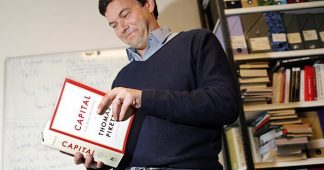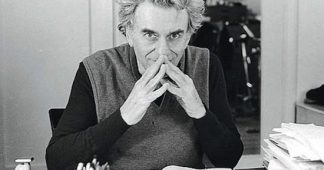Although neoclassical economics relies on assumptions that should have been discarded long ago, it remains the mainstream orthodoxy. Three recent books, and one older one, help to show why its staying power should be regarded as a scandal.
The four books reviewed here each uncover parts of the scandal. Three are brand new, and the other, The Corruption of Economics, first appeared in 1994 and was re-issued in 2006. Its principal author, the American economist Mason Gaffney, kept his remarkable pen flowing until passing away last summer at the age of 96.
Economics Without History
Robert Skidelsky is a historian, an epic biographer of John Maynard Keynes, and a prolific debater in the United Kingdom’s House of Lords. He calls What’s Wrong with Economics? a “primer,” and it is indeed the most accessible of the four books. Skidelsky’s education in the history of economics resembles my own: a wide reading of the classical authors – Adam Smith, David Ricardo, Karl Marx, and others – followed by those associated with the “neoclassical” or “marginalist” revolution of the 1870s.
It was this latter group that shifted the discipline’s focus from social classes (landlords, capitalists, workers) to individual units (households, firms) and declared that these units interacted to maximize not “surplus” but “utility” and efficiency. The marginalists also introduced a “sophisticated” mathematical technique to the field: namely, the differential calculus, with which one can show that maximum efficiency is reached when firms are small and competitive, as this tends to reduce profits to zero. Although the neoclassical hegemony was disrupted by the Great Depression and the rise of Keynesian models, that period proved to be merely a 40-year digression. The economics profession today is as Skidelsky describes it: an army of neoclassical technicians.
But what, exactly, is this army doing? It is hard to find an answer in Skidelsky’s book, largely because he is offering a high-altitude perspective. He makes a point of quoting only the “best” of the mainstream economists, meaning famous twentieth-century names like Paul Samuelson, Milton Friedman, Mancur Olson, Robert Lucas, and others who wrote about economics after having made their marks on the field. Skidelsky wants economics to be a multidisciplinary subject again. The problem is that economics no longer encourages reflection on its own philosophical foundations. It consists, rather, of the application of settled techniques – constrained optimization of intertemporal utility functions, “computable general equilibria,” and the “dynamic stochastic general equilibrium” model in “macroeconomics.” With these tools, academics compete for attention, citations, rankings, promotions, and – above all – the approval of those who taught them those tools in the first place. As such, Skidelsky’s appeal for a return to an economics that is rooted in history, sensitive to ethics, and alert to the limits of the “self-regulating” market is doomed to fall on deaf ears. The average economist today has been trained to disparage such things, regarding them as at best a waste of time, and at worst as a threat to one’s personal professional standing. “Today we are living through a crisis of liberalism,” Skidelsky writes. “The financial collapse has brought to a head a growing dissatisfaction with the corruption of money. Neoconservatism has sought to justify fabulous rewards to a financial plutocracy while median incomes stagnate or even fall; in the name of efficiency it has promoted the offshoring of millions of jobs, the undermining of national communities, and the rape of nature… What this kind of history offers students of economics is the ability to situate themselves and their teaching in the flow of events.” Try selling that argument to a card-carrying economist. It is not that all economists are evil reactionaries on the take from the Koch empire (though some are). It is that they simply cannot countenance the idea that they are playing a political or ideological role, rather than simply deploying the “tools of economics” to answer a vast variety of specific questions. Their goal is mostly (though not always) well-meaning; they want to improve the world without challenging or changing anything fundamental. Their self-assurance is unshakable.
From Art to Pseudoscience
Where does economists’ certitude come from? In The Age of Fragmentation, Italian economist Alessandro Roncaglia, formerly of Sapienza University of Rome, provides a wide-ranging critical history of contemporary mainstream economic thought. Roncaglia is lucid and concise, including in his presentation of dissenting views. Given that we are dealing here with matters of philosophy, logic, and mathematics, The Age of Fragmentation is undoubtedly a challenging read. But the overall effect is clear, unpolemical, and, broadly speaking, devastating to mainstream economics’ scientific pretensions.
The neoclassical origin myth holds that the “marginalist revolution” of the 1870s brought three fundamental changes in economic perspective. The first was the aforementioned shift in focus from social classes to individuals, and correspondingly from production and profit to consumption, choice, and utility. The second was the elimination of considerations of power from economic analysis: the emphasis on struggle, exploitation, and conflict that defined what earlier practitioners called political economy gave way to a view of markets as mechanisms of benign cooperation that turned self-interested behavior into a common good. Following from those changes came the notion of general equilibrium, which imputes to the economy a kind of celestial harmony reminiscent of the serene social philosophy of imperial China (from which the idea was derived). With these shifts, the new hegemony had been established. By the 1970s, if prior doctrines – such as the labor theory of value – were mentioned to graduate students at all, it was only to assert that economists in the previous century had been forced by some vague but insuperable logical difficulty to abandon the old track for the new one. But, in fact, it wasn’t like that at all. Early marginalists such as Léon Walras, Stanley Jevons, Carl Menger, and Alfred Marshall were not learned students and critics of Marx. They arrived on the scene only a few years after the first volume of Marx’s Capital appeared, having swept into economics from the worlds of engineering and early thermodynamics. Parading differential and integral equations that they themselves did not quite understand, they perplexed their contemporaries in math and physics but nonetheless gained a decisive advantage over the mostly innumerate types who did economics in those days.
Roncaglia shows that despite a vast increase in the expressive algebraic content of economic research, the logical gaps in the early marginalists’ models were never closed, nor were most of their errors corrected. The issue is not that modern mainstream economists are mathematically sloppy. It is that the smooth substitutions their equations portray correspond to nothing in the real world. Roncaglia also reminds us that the classical tradition in economics did not disappear altogether. Though confined to an ever-shrinking margin of the field, it has persisted, notably in the work of scholars such as Piero Sraffa (“The Revolutionary”), Joan Robinson, Nicholas Kaldor, and the great Italian theorist Luigi Pasinetti, who is still active at 90. As these economists recognized, the classical tradition’s concepts of diminishing and increasing returns served specific and distinct functions. For example, diminishing returns explained rent – the extra product, above wages and competitive profits, accruing to the owners of the more fertile grades of land. And increasing returns captured progress over time as trade expanded, technology improved, the division of labor increased, and costs fell. It is neoclassical wishful thinking to believe that firms with declining costs can comprise industries that are stably competitive in the neoclassical sense. This observation should be obvious in a world dominated by companies like Google, Facebook, and Amazon, yet it still flies over the heads of latter-day antitrusters. Here, Sraffa’s 1926 conclusion about Marshall’s theory, quoted by Roncaglia, bears repeating: “Marshall’s theory… cannot be interpreted in a way which makes it logically self-consistent and, at the same time, reconciles it with the facts that it sets out to explain… I think… that it should be discarded.” But Marshall’s theory of market equilibrium based on perfect competition was not discarded. Instead his intellectual heirs abandoned the effort to fit economic theory into evolutionary time – that is, into the real world – and continued to pursue ever-more complex calculations of optimization. Their trick was to stretch that concept through time by means of present-value discounting while still assuming that all decisions will be made once and for all at the outset. In their “rational expectations” models, each factor is rewarded according to its “marginal product,” and the equilibrium thereafter is disturbed only by “random errors” or “exogenous shocks.” Because the neoclassical school is preoccupied with “efficiency,” as determined by “Pareto optimality,” it has no need for discussions of distributive justice. As a result, the key classical concept of land disappeared from economic science – as did the Ricardian axiom that rent is surplus and therefore the most appropriate object of taxation. Needless to say, studying such a subject requires a particular combination of intellectual complacency, deference, middling mathematical skills, and careerism. I was struck by these qualities in my fellow students 45 years ago at Yale. Though the economics department there was relatively tolerant, we knew even then that overly persistent dissent was a bad career move. But this didn’t really matter for most students. The problems summarized in Roncaglia’s book were so deeply buried in the symbolic notation of formal models that most were unaware of their existence.
The Revolt of the General Theory
The defeat and suppression of the classical perspective – with its evolutionary, institutionalist, and developmental descendants – cleared the way for a dogmatic economics that exalted self-regulating competitive markets. Not incidentally, the new hegemony lent itself to the view that governments should intervene only to remove institutional rigidities – monopolies, trade unions, managed prices, food and fuel subsidies, and so forth – preventing realization of the competitive ideal. As we have seen, this perspective soon ran into serious – but temporary – difficulties with the Great Depression, mass unemployment, and the rise of Keynes, whose theory is revived in Harvard University economist Stephen A. Marglin’s Raising Keynes. At 896 pages and with a minimalist red-lettered cover, those in charge of marketing Marglin’s book are evidently basking in the afterglow of Thomas Piketty’s global bestseller Capital in the Twenty-First Century. But make no mistake: Raising Keynes is a far better and more carefully composed book.
Marglin has carried out the daunting task of rewriting, almost chapter for chapter, Keynes’s 1936 General Theory of Employment, Interest, and Money – complete with myriad graphics and mathematical appendices. Moreover, he gives us what he believes would have been Keynes’s response to all of the subsequent interpretations, criticisms, and inversions of his work, most of which came from economists at MIT (including Samuelson, Franco Modigliani, and Robert Solow) and the University of Chicago (such as Friedman, Lucas, and George Stigler). Marglin’s basic argument is stated in two parts. First, he focuses on the “Keynesian first-pass model” in the context of the static, general equilibrium framework favored by John Hicks (this is known in textbooks as the IS-LM model). He concludes that within that framework, Keynes’s theory is reduced to dealing with “frictions and rigidities,” implying that “if only” markets were competitive in the neoclassical mode, mass unemployment could not exist. This view, overwhelmingly dominant among mainstream economists to this day, justifies what journalists call “Keynesian policies”: easy money and budget deficits to fight unemployment. The implication is that eliminating pesky rigidities is just too hard (unless done at gunpoint, as in General Augusto Pinochet’s Chile, or by external diktat, as in many later cases, notably Greece at the hands of the International Monetary Fund a decade ago). In his “second-pass model,” Marglin resets Keynes in a dynamic frame, dealing with events and changes that occur through time – a manner of thinking that we know from Roncaglia to have been habitual among the classical economists. Crucial elements that can change over time include a business’s hopes and fears for future profits, investors’ desire for yield relative to the security of holding cash, and the willingness of banks to supply loans – thereby creating “bank money” – to those seeking economic gain. In this world – the real world – decisions with uncertain prospects are taken sequentially, and it is the decisions themselves that matter – not whether they happened to be based on “rational” forecasts or whether the course of events was disturbed by some unforeseeable shock.
Like Keynes, Marglin argues, correctly, that in this world, persistent involuntary unemployment cannot be resolved by cutting wages and breaking unions, even if you can get away with doing these things. Here, Marglin is, in effect, restating what Keynes’s closest collaborators always argued. My first encounter with Robinson came in a University of Cambridge lecture hall in 1974. She had been sitting in to heckle Frank Hahn, one of the leading neoclassicists there at the time. As undergraduates fled the scene, I introduced myself and she invited me to lunch. Once seated in the buttery of the University Library, she started in: “You can’t put time on the IS-LM diagram. Time comes out of the blackboard.” I had no idea what she was talking about, but she certainly did (and now so do I). Marglin is faithful to Keynes except to the extent that he has internalized the MIT Keynesians views, methods, equations, and graphs. This leads him to take Keynes’s expositional concessions to the terminology of static models as more essential than they were. It also leads him to overlook the theory of money that Keynes set forth at enormous length six years previously, in A Treatise on Money (even though he quotes that text). He avers, condescendingly, that Keynes was expressing intuitions but “lacked the tools” to make a proper job of his own General Theory. If any of that were true, Keynes would have been justly forgotten, and Marglin would have had no reason to write his book. Nevertheless, Marglin has taken 80 years of neoclassical distortions of Keynes, presented them with great clarity in their own language, and then pounded them into dust, pushing the detritus back into the faces of the high priests of the neoclassical synthesis, the New Keynesians, and the New Classical Economists. Raising Keynes issues a challenge that they would be cowardly to refuse – which is not to suggest that they won’t do their best to ignore it.
The Man Who Said Too Much
Unfortunately, Sraffa’s name and work do not appear in Marglin’s book. This critical omission means that Marglin misses altogether the links between Keynes and the classical tradition, not least Ricardo’s work on the question of taxation and the role of redistribution as a spur to increase efficiency (the opposite of the neoclassical efficiency-equity tradeoff). For the classical school, taxation was not a source of distortion of otherwise fair and just markets. It was a way to discourage the unproductive, wasteful, and inessential elements of those markets, thereby relieving the burden on both labor and capital. The inessential element par excellence was rent, the predatory class were the landlords, and the fuel for general improvements was to be found by taxing land rents and using the proceeds to build roads, bridges, waterworks, hospitals, schools, and the means of security. That was Ricardo’s view, on behalf of the capitalists, and it would later find its most formidable proponent in the late nineteenth-century American journalist Henry George. Skidelsky, Roncaglia, and Marglin do not mention George, because he has largely been dropped from the history of economic thought. But George’s book Progress and Poverty sold millions of copies around the world in the half-century between 1870 to 1920. His proposed Single Tax (on land rent) influenced early twentieth-century Liberal Party governments in the United Kingdom, California water policies, and the politics of New York City (where George challenged Wall Street directly by running for Mayor) as well as many other cities across America. Indeed, the future leader of republican China, Sun Yat-sen, was a Georgist, and through him George still exerts a large influence over the People’s Republic, which can finance history’s greatest wave of public works because the Revolution gave the government effective control of land. Georgism brought us the progressive income tax and direct election to the US Senate. There are Georgist institutes and journals in America to this day, but they are considered disreputable, and are ignored by neoclassical, Marxian, and Keynesian economists alike. Their ideas go unmentioned and untaught in economics departments, and their groups are unrepresented even among the many tolerated splinter associations that meet each year as the Allied Social Sciences Association, under the aegis of the American Economic Association (AEA). Why is that? In The Corruption of Economics, Gaffney and fellow Georgist Fred Harrison begin their inquiry with the observation that America’s nineteenth-century universities, like its railroads, were land-grant institutions, vested with warrants to vast acreages under the 1862 Morrill Act. They were thus not only noble outposts of practical learning but also highly appealing vehicles for enterprising captains of land speculation. For these men, to found and run a university combined honor, influence, glory, and a not inconsiderable chance to become very rich. But the Georgist idea that land alone should be taxed – so as not to tax either profits or wages – threatened to create a dangerous political alliance between capital and labor against the landlord.
The land-grant universities therefore hired and promoted a retinue of mediocrities willing to wage a war of derision and dismissal against George’s noxious creed. These were the founders of modern American economics, and Gaffney and Harrison document their words, commitments, careerism, and venality in rich detail, leaving no doubt about their true characters and beliefs. Their names – Richard Ely, Francis Walker, and John Bates Clark – are now forgotten, or would be except for the fact that each is or has been commemorated annually with a lecture or medal offered by the AEA.
Gaffney and Harrison argue that in American academia, Marxians historically could be tolerated in small numbers precisely because they posed no real threat. They were a minor concession to tendencies that had greater force elsewhere, and, conveniently, their doctrine (that capital is opposed dialectically to labor) left out the landlords.
But it was not only Georgists who were kicked off of mainstream economics’ ladder of prestige. So, too, were followers of Thorstein Veblen, who threatened the neoclassicals with evolutionary methods, anthropological analogy, and satire. Kaldor, Robinson, Sraffa, and other followers of Keynes who never played along with the neoclassical straitjacket of static equilibrium were similarly banished from the curriculum, as were those influenced by my father, John Kenneth Galbraith, who noted the dominance of organizations over markets. Each was treated the same way: with disdain and ad hominem (ad feminam in Robinson’s case) disparagement. (Eventually, the Marxians, too, were purged, once the end of the Cold War fatally weakened their position.)
And so, neoclassical economics perpetuates itself by replicating a single set of methods in a handful of leading journals to which no dissenters have access. There, the faithful continue to offer analyses that are of no interest to anyone who has grasped the evolutionary methodology common to all the important dissenting schools. Under neoclassical economics, the subject is defined by what it excludes: the simple fact that things change over time. Its practitioners harbor an affinity for Intelligent Design – the belief in a transcendent celestial harmony that is at odds with the development of actual scientific thought since Charles Darwin’s The Origin of Species appeared in 1859.
The latest group of heretics are the advocates of Modern Monetary Theory, who have developed Keynes and Hyman Minsky’s real-time, uncertainty-driven, bank-money chartalism into a full-fledged critique of fraud and regulatory failure in the financial sector. In leading universities, governed at their highest levels these days by financiers, this group, no surprise, is treated as beneath contempt.
* James K. Galbraith, Professor of Government and Chair in Government/Business Relations at the University of Texas at Austin, is a former staff economist for the House Banking Committee and a former executive director of the Joint Economic Committee of Congress. From 1993-97, he served as chief technical adviser for macroeconomic reform to China’s State Planning Commission. He is the author of Inequality: What Everyone Needs to Know (Oxford University Press, 2016) and Welcome to the Poisoned Chalice: The Destruction of Greece and the Future of Europe (Yale University Press, 2016).
We remind our readers that publication of articles on our site does not mean that we agree with what is written. Our policy is to publish anything which we consider of interest, so as to assist our readers in forming their opinions. Sometimes we even publish articles with which we totally disagree, since we believe it is important for our readers to be informed on as wide a spectrum of views as possible.












Mason Gaffney and Fred Harrison, The Corruption of Economics, Shepheard-Walwyn Publishers Ltd., 2006 (first published 1994).
Stephen A. Marglin, Raising Keynes: A Twenty-First-Century General Theory, Harvard University Press, 2021.
Alessandro Roncaglia, The Age of Fragmentation: A History of Contemporary Economic Thought, Cambridge University Press, 2019.
Robert Skidelsky, What’s Wrong with Economics?: A Primer for the Perplexed, Yale University Press, 2020.
AUSTIN – Self-regarding economics departments at prestigious academic institutions no longer bother to teach the history of economic thought – a field that I studied at Yale University in 1977, forever compromising my academic career. Why was the topic abandoned – and even shunned and mocked? Students with a skeptical turn of mind would not be wrong to suspect that it was for scandalous reasons (as when, in past centuries, inconvenient aunts were locked away in garrets).